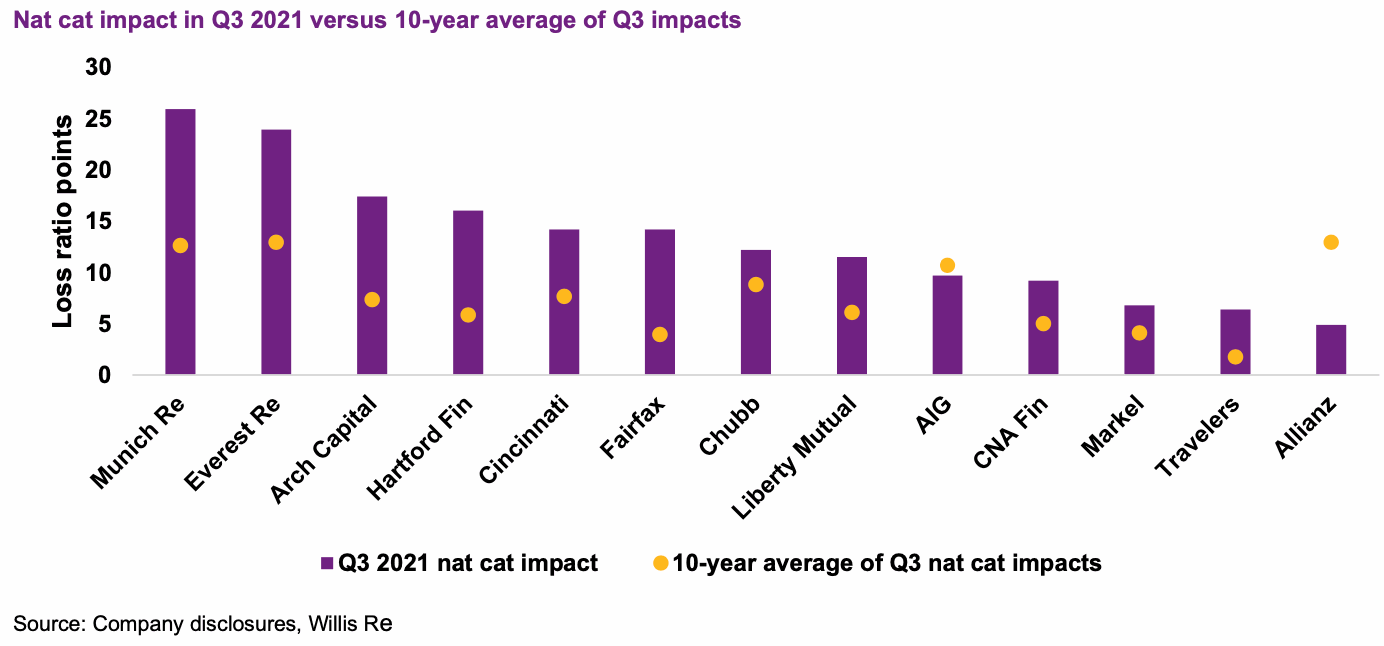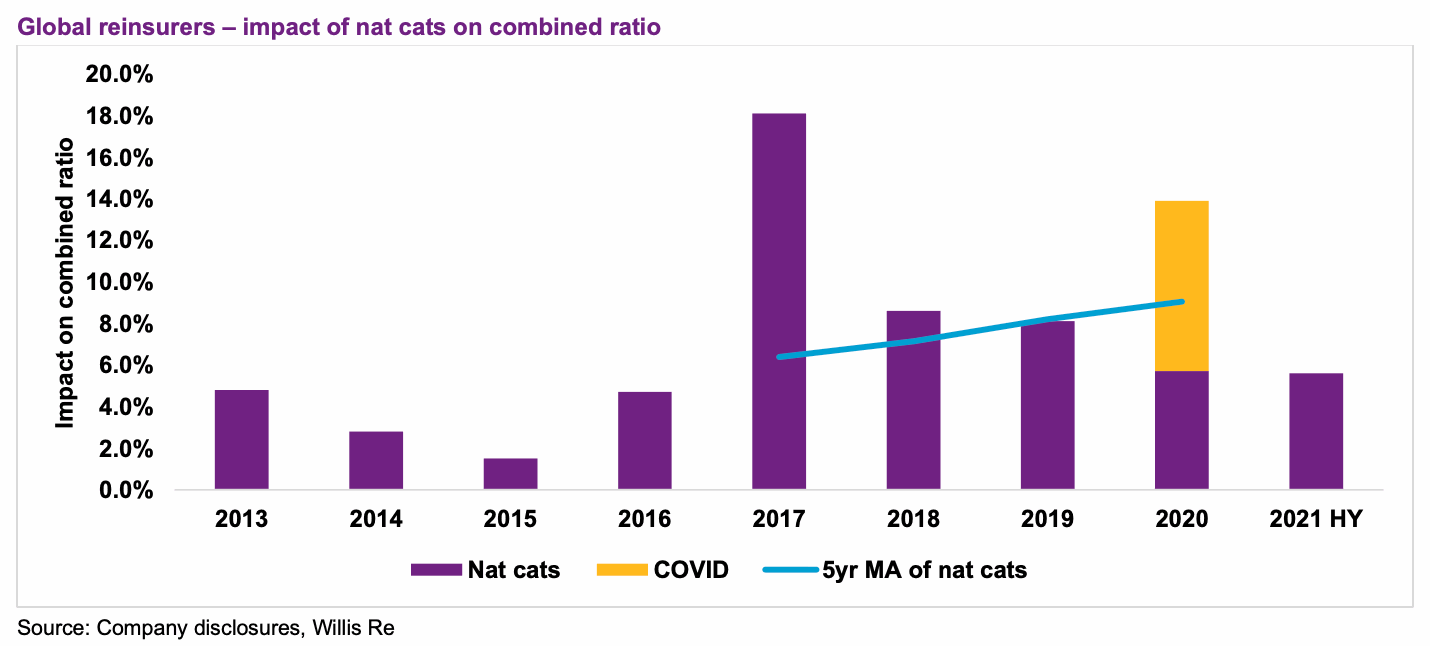Recent historical natural catastrophe loss trends are driving an increasing focus on the sufficiency of reinsurance and retrocession, global broker Willis Re explained today.
The reinsurance broker expects a continued heightened attention on natural catastrophe perils, after the significant losses experienced in the third-quarter of 2021.
In particularly, attention will be turned to three areas, Willis Re believes, understanding exposure and what it means, reinsurance or retrocessional protection and whether it is sufficient, as well as pricing on the front-end for inward risks.
On top of this, there is an industry-wide conversation, that is growing in volume, on what actually constitutes a normal year of nat cat losses, Willis Re said.
The industry is trying to work out how to better understand and manage trends in catastrophe and severe weather frequency and severity, to insulate its results against challenging quarters like we’ve just seen.
That said, Willis Re notes that for the first-nine months of the year, largely reinsurers results are improved over the previous one, with a lower average combined ratio.
Combined ratios for Q3 alone show an increase, when aggregated, but still performance has not been as negatively impacted as you might have thought, with a significant reason for this being recent pricing trends and the firmer rate environment, as well as some companies already well-underway push to better manage catastrophe exposures.
Reinsurance has played a key role in this as well, with some re/insurers protections coming into their own in Q3, helping them to better weather the weather and report less bad results than observers might have anticipated.
There is an expectations of more rate increases being secured, at renewals and through the end of this year and into 2022.
In fact, Willis Re notes that, “Management teams are typically expecting favourable pricing to continue for the remainder of the year and into 2022, with some noting renewed rate improvement for certain lines of business which had previously shown signs of stabilisation, likely due to large cat events during the third quarter.”
Importantly, “Rates are likely outpacing loss cost trends for most lines of business,” Willis Re explained, which has driven better-than-expected results, but uncertainty still remains over natural catastrophe exposures.
While hurricane Ida has been the biggest driver of cat loss in 2021, so far, the contribution of secondary perils has again been significant, particularly from the European flooding and the Texas winter storms and freeze event earlier in the year.
The chart below shows how some of the major global insurance and reinsurance players fared in Q3, showing far above average (and likely also budget) catastrophe losses for many, but also highlighting a few that have already been making sweeping changes to their reinsurance over the last few years.

While the past quarter saw heavy catastrophe losses for many companies, it has actually continued a bit of a trend of elevated cat and severe weather losses, Willis Re’s data shows.
In fact, Willis Re says that the five-year moving average natural catastrophe impact on combined ratios has risen from 6% in 2017 to 9% in 2020 and the chart below shows that 2021 just at the half-year was already a significant contributor. By now it may be above 2018 and 2019 and on a cat only basis, likely second only to 2017.

For the majority of insurers and reinsurers that provide guidance on a typical level of catastrophe losses, Willis Re believes 2021 will go over budget again.
“For these companies, over the past five years, experience has generally exceeded ‘normal’ in 3-4 of these years. If you throw in the COVID-impacted 2020 (strictly speaking, not a nat cat), it becomes 4-5 years out of five. However, some companies have indicated that the past five years are not necessarily indicative of ongoing ‘normal’,” the reinsurance broker explains.
Because of this, Willis Re said, “We expect the recent experience and trend to continue to drive a heightened focus on modelling exposure (particularly for secondary perils and climate change), the sufficiency of reinsurance (or retrocession) protection in place, and whether exposures are being adequately reflected in price (both in original and reinsurance terms).”
It’s clear that some companies are weathering the impacts of catastrophes better than others and among them are some that have restructured their reinsurance and retrocession more significantly, often bought more protection and often leverage third-party capital as well.
If the trend is moving towards higher average losses, for any reason from climate, to social inflation, to economic exposure growth, then companies need to get more strategic about their protection buying, use of and sourcing of underwriting capital, as well as managing their inward exposures, in order to avoid over-exposure and continuing to have above-budget cat loss years.
 View all of our Artemis Live video interviews and subscribe to our podcast.
View all of our Artemis Live video interviews and subscribe to our podcast.
All of our Artemis Live insurance-linked securities (ILS), catastrophe bonds and reinsurance video content and video interviews can be accessed online.
Our Artemis Live podcast can be subscribed to using the typical podcast services providers, including Apple, Google, Spotify and more.































